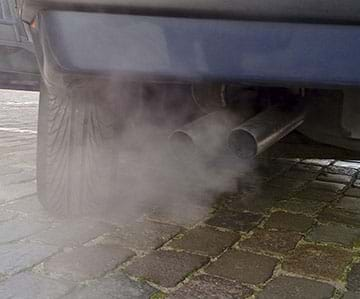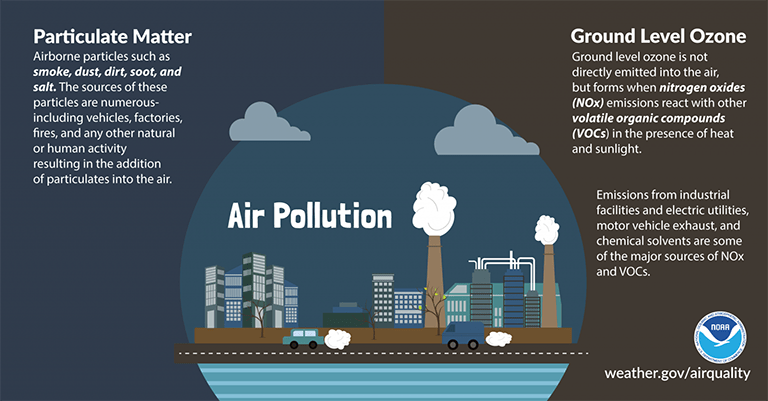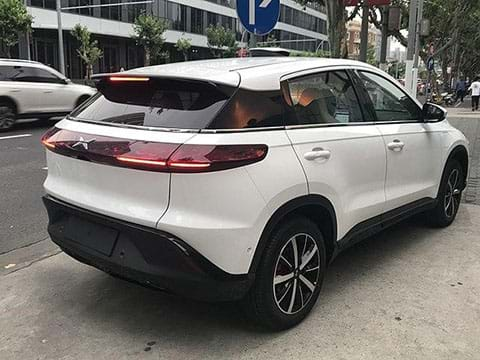Quick Look
Grade Level: 2 (K-2)
Time Required: 45 minutes
Lesson Dependency: None
Subject Areas: Earth and Space
NGSS Performance Expectations:

| K-2-ETS1-1 |
| K-ESS3-3 |

Summary
This lesson introduces students to the concepts of air pollution from transportation and related health effects, plus vehicle solutions to help reduce air pollution and improve air quality. First, students watch a video of vehicles in traffic and reflect on what they observed. Next, they learn about particulate matter (PM), a primary air pollutant, and do basic visual air quality and PM health effects assessments. Finally, students compare and contrast gas-powered and electric vehicles in relation to their energy sources and impacts on air quality.Engineering Connection
Developing new technologies that use alternative energy sources is key to designing clean-energy cars, which help improve air quality.
Chemical engineers improve current battery technologies and develop new battery designs.
Electrical engineers design the electrical circuitry to charge the battery and distribute the electricity from the battery to the electric motor.
Many electric vehicles are made of newer materials that are lighter and stronger and may incorporate environmentally-friendly materials, which materials engineers develop, process, and test.
Mechanical engineers design, develop, and test mechanical devices in electric vehicles including electric motors, transmissions, drivetrains, and steering systems.
Learning Objectives
After this lesson, students should be able to:
- Recall that particulate matter (PM) affects air quality and people’s health.
- Recognize particulate matter (PM) come from gas-powered vehicle emissions and not from electric vehicles (EVs), which do not create or release any emissions (zero-emission).
Educational Standards
Each TeachEngineering lesson or activity is correlated to one or more K-12 science,
technology, engineering or math (STEM) educational standards.
All 100,000+ K-12 STEM standards covered in TeachEngineering are collected, maintained and packaged by the Achievement Standards Network (ASN),
a project of D2L (www.achievementstandards.org).
In the ASN, standards are hierarchically structured: first by source; e.g., by state; within source by type; e.g., science or mathematics;
within type by subtype, then by grade, etc.
Each TeachEngineering lesson or activity is correlated to one or more K-12 science, technology, engineering or math (STEM) educational standards.
All 100,000+ K-12 STEM standards covered in TeachEngineering are collected, maintained and packaged by the Achievement Standards Network (ASN), a project of D2L (www.achievementstandards.org).
In the ASN, standards are hierarchically structured: first by source; e.g., by state; within source by type; e.g., science or mathematics; within type by subtype, then by grade, etc.
NGSS: Next Generation Science Standards - Science
| NGSS Performance Expectation | ||
|---|---|---|
|
K-2-ETS1-1. Ask questions, make observations, and gather information about a situation people want to change to define a simple problem that can be solved through the development of a new or improved object or tool. (Grades K - 2) Do you agree with this alignment? |
||
| Click to view other curriculum aligned to this Performance Expectation | ||
| This lesson focuses on the following Three Dimensional Learning aspects of NGSS: | ||
| Science & Engineering Practices | Disciplinary Core Ideas | Crosscutting Concepts |
| Ask questions based on observations to find more information about the natural and/or designed world(s). Alignment agreement: | A situation that people want to change or create can be approached as a problem to be solved through engineering. Alignment agreement: Asking questions, making observations, and gathering information are helpful in thinking about problems.Alignment agreement: | |
| NGSS Performance Expectation | ||
|---|---|---|
|
K-ESS3-3. Communicate solutions that will reduce the impact of humans on the land, water, air, and/or other living things in the local environment. (Grade K) Do you agree with this alignment? |
||
| Click to view other curriculum aligned to this Performance Expectation | ||
| This lesson focuses on the following Three Dimensional Learning aspects of NGSS: | ||
| Science & Engineering Practices | Disciplinary Core Ideas | Crosscutting Concepts |
| Communicate solutions with others in oral and/or written forms using models and/or drawings that provide detail about scientific ideas. Alignment agreement: | Things that people do to live comfortably can affect the world around them. But they can make choices that reduce their impacts on the land, water, air, and other living things. Alignment agreement: Designs can be conveyed through sketches, drawings, or physical models. These representations are useful in communicating ideas for a problem's solutions to other people.Alignment agreement: | Events have causes that generate observable patterns. Alignment agreement: |
International Technology and Engineering Educators Association - Technology
-
Illustrate helpful and harmful effects of technology.
(Grades
Pre-K -
2)
More Details
Do you agree with this alignment?
Worksheets and Attachments
Visit [www.teachengineering.org/lessons/view/cub-2632-cars-air-quality-connections-k-2-lesson] to print or download.Pre-Req Knowledge
A basic understanding that clean air is essential for people’s and other living things’ survival.
Introduction/Motivation
Today, we will use our sense of observation, which is how we look at things to understand them, to explore two types of cars—gas-powered cars, and electric vehicles, also known as EVs.
We will first learn about how cars affect air quality, which is a way to measure how clean our air is. We will also learn about a type of transportation produced air pollutant, called particulate matter, or PM for short, which causes air pollution.
Then, we will see how PM affects the air around us. Next, we will look at how PM affects our health if we breathe in air with a lot of PM.
Finally, we will compare and contrast gas-powered and EVs to see if these vehicles affect the air we breathe and our health.
Lesson Background and Concepts for Teachers
A basic understanding of how gas-powered combustion engines work compared to how EV battery-powered motors work is helpful.
Gas-powered vehicles burn gasoline, a fossil fuel, for energy, which releases emissions from exhaust tailpipes in vehicles into the air. These emissions contain a variety of air pollutants, including particulate matter, also known as PM. PM poses significant human health risks, especially fine PM 2.5, which can enter the bloodstream and affect various body organs and cause disease. Coarse PM 10 when it accumulates in the atmosphere creates haze and limits visibility. PM pollution affects air quality, also known as AQ. AQ is a measure of how healthy the air is to breathe.

EVs, which are powered by batteries, not the burning of fuels, do not release any emissions into the atmosphere. As such, EVs do not create or release any air pollution and are referred to as zero-emission vehicles.

Procedure:
- As a think-pair-share activity, ask students the following pre-lesson assessment questions. Write each question in turn on the whiteboard or smartboard and, and write students’ responses as they share their thoughts:
- Do you think clean air is important?
- What makes the air dirty?
- Are there ways to keep the air clean or make dirty air clean?
- Share that the focus for today’s lesson is on how vehicles (cars)affect how clean the air is, and if there are transportation solutions to help clean the air.
- Explain to students that they are working in teams of two as environmental engineers to explore how vehicles affect how clean the air is to breathe, which we call air quality, by finding out about transportation-related air pollution. Also, they will compare two different types of cars—gas-powered (internal combustion engine) and EV (electric vehicle)— to find out if either one helps make our air cleaner and healthier to breathe.
- Assign partners, and hand out a Cars and Air Quality Connections Worksheet to each student.
- Read the Essential Questions on the worksheet aloud to remind the “engineering teams’ what to think about as they observe and complete each step of the worksheet together.
- In section 1 of the worksheet, show the video of cars in traffic to the class. Ask students to draw or write about what they observed. Have a brief class discussion on whether students think cars affect how clean the air is.
- In section 2 of the worksheet, tell students let's find out about one type of air pollution called particulate matter, or PM for short, that comes from certain types of cars. Show the class the air pollution video (stop at 2:24). After watching the video, review key points about PM that are described in the worksheet. Have students work with their partners to observe images and answer the questions that are listed. Review student responses as a class, and ask for volunteers to explain and/or write their responses on the whiteboard or SmartBoard.
- In section 3 of the worksheet, ask students to identify different Health impacts from breathing PM air pollution. Again with their engineered partner, have students match each phrase with its corresponding image. Discuss as a class students’ responses and what they notice about the effects of breathing PM air pollution are on people's health.
- In section 4 of the worksheet, tell students that now that they understand more about PM air pollution and its effect on our health, they are going to explore how two different types of cars—gas-powered cars and electric vehicles, also known as EVs—Impact the level of air pollution and our help. Show the video on gas-powered vehicles. Next, show the video on EVs. Ask student teams to discuss how both types of cars are similar by drawing and writing their responses. Then a student teams to discuss how both types of cars are different and draw and write their responses.
- Finally, have a class discussion On the following summative assessment questions:
- Is clean air important? Explain.
- Do gas-powered or electric cars make our air dirtier?
- Do gas-powered or electric cars make our air cleaner?
Associated Activities
- Air Quality and Particulate Matter - This activity introduces students to the relationship between air quality and wind. Students work together to learn about the color-coded Air Quality Index (AQI) chart that describes levels of air pollution for a primary transportation-sourced air pollutant—particulate matter (PM)— and what to do during high pollution days.
Lesson Closure
Way to go! The class did an awesome job exploring two different types of cars—gas-powered cars and electric vehicles, and how each type affects our air and health. Now imagine in the future you are driving your first car, which type of car would you like to drive and why?
Vocabulary/Definitions
air pollution: A mixture of solid particles and gases in the air from human-made sources such as car exhaust (emissions), chemicals from factories, and natural sources such as dust, pollen, and mold.
air quality: A measure of how clean or dirty the air is.
Electric vehicle (EV): A vehicle with a motor that runs on rechargeable battery power and does not release any exhaust or air pollutants into the air (zero emissions).
emissions: Something that is released or given off (e.g., car exhaust).
gas-powered vehicle: A vehicle with an engine that runs by burning gas (fossil fuel) and releases exhaust (emissions) that contains air pollutants into the air.
Particulate matter (PM): Air pollution that is made up of very small particles in the air that come from natural sources (wildfire smoke, dust) and human-made sources (vehicle and factory exhaust).
pollutant: A chemical or biological substance that harms water, air, or land quality.
Assessment
Pre-Lesson Assessment
Discussion Questions: Ask the students and discuss as a class:
- Do you think clean air is important? What makes the air dirty? Are there ways to make dirty air clean? Tell students they will find out more about how vehicles (cars) affect how clean the air is in the activity.
Lesson Embedded (Formative) Assessment
Guided Worksheet: Scaffold students’ learning by having them work in pairs and a whole class as they complete the Cars and Air Quality Connections Worksheet with a partner, as directed in the Procedure section.
Post-Lesson (Summative) Assessment
Class Reflection: Ask students to share one thing they learned or still wonder about regarding the relationship between cars, air pollution, and health.
Making Sense: Have students reflect on the science concepts they explored and/or the science and engineering skills they used, plus questions or ideas they have by completing a modified Making Sense Assessment.
Lesson Extension Activities
Lead students on a walking field trip around their school to find out if certain areas have more or less vehicle traffic and signs of transportation-related air pollution.
Additional Multimedia Support
The Electric Vehicle Solution: https://www.youtube.com/watch?v=V5w2TiEohs8
The Electric Vehicle Solution (Spanish version): https://www.youtube.com/watch?v=TOGdJIzg3TY
Evie the Electric Car: https://www.youtube.com/watch?v=RJkqaGCdFQQ
Subscribe
Get the inside scoop on all things TeachEngineering such as new site features, curriculum updates, video releases, and more by signing up for our newsletter!More Curriculum Like This

This lesson introduces students to the concepts of air pollution from transportation and related health effects, plus vehicle solutions to help reduce air pollution and improve air quality.

This activity introduces students to the relationship between air quality and wind. Students work together to learn about the color-coded Air Quality Index (AQI) chart that describes levels of air pollution for a primary transportation-sourced air pollutant—particulate matter (PM)— and what to do du...

Looking at transportation and the environment, students learn that some human-made creations, such as vehicles, can harm the natural environment. They also learn about alternative fuels and vehicles designed by engineers to minimize pollution. The associated hands-on activity gives students a chance...
References
Bureau of Labor Statistics. Accessed August 18, 2021. (Source of Engineering Connections)
https://www.bls.gov/green/electric_vehicles/
Armstrong, Patricia. Bloom’s Taxonomy. 2021. Vanderbilt University Center for Teaching. https://cft.vanderbilt.edu/guides-sub-pages/blooms-taxonomy/
NOAA, Accessed August 18, 2021. (Source of Investigating/Essential Questions) https://www.weather.gov/wrn/summer-article-clearing-the-air
US EPA. Accessed August 18, 2021. (Source of particulate matter information) https://www.epa.gov/pm-pollution
Other Related Information
Copyright
© 2022 by Regents of the University of ColoradoContributors
Jennifer Taylor, University of Colorado Boulder, Integrated Teaching and Learning Program, Pre-College Engineering EducationSupporting Program
Integrated Teaching and Learning Program, Pre-College Engineering Education, University of Colorado BoulderAcknowledgements
This curriculum was developed under National Science Foundation grant number 1941524. Any opinions, findings, and conclusions, or recommendations expressed in this material are those of the authors and do not necessarily reflect the views of the National Science Foundation.
This curriculum was developed with support from the AEROKATS and ROVER Education Network (AREN) (Henry/NNX16AB95A). AREN is a NASA Science Mission Directorate Science Activation (SciAct) Program.
Last modified: August 27, 2024







User Comments & Tips